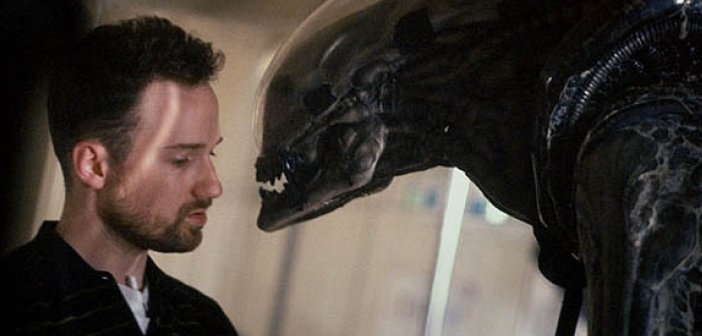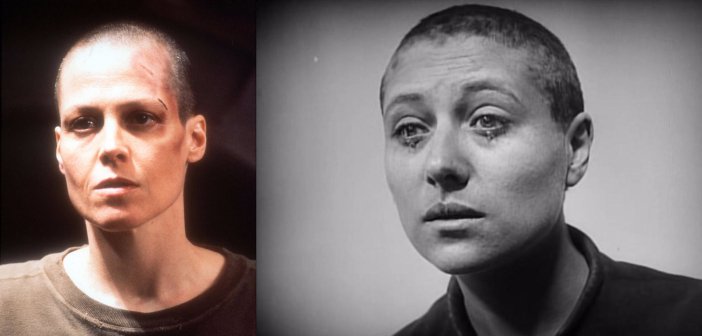Alien 3 | In Defence of David Fincher’s Alien Entry 25 Years Later
Alien 3 suffered a disastrous production. It’s original writer-director Vincent Ward (Map of the Human Heart) proposed the idea of Ripley crash-landing on a wooden planet comprised solely of monks. Weaver’s character would be a Christ in reverse bringing with her a xenomorph – whom the priests believe to be the devil. Too ambitious for studios, Ward was asked to tone down the script – eventually being sacked for refusing to do so. His ideas were then blended with other Alien sequel scripts. Screenwriter David Twohy (Riddick) pitched a prison setting, one which was used and then later expanded upon in his own directorial effort Pitch Black. Meanwhile, other big-names like Renny Harlin, Walter Hill, Neuromancer author William Gibson and eventual director David Fincher all contributed script-work to varying degrees.
On top of the script mess, other issues plagued production. Cinematographer Jordan Cronenweth (Blade Runner, Altered States) was forced off the picture two weeks into shooting after he began to suffer the onset of Parkinson’s disease. Michael Biehn, the actor who played hero Hicks in Aliens, outspokenly slammed the movie for the blasé approach it took to killing his character. Meanwhile, Alien 3’s director David Fincher (who went on to make Fight Club, Seven and Zodiac, but at the time only a music-video director) had his creative control limited by 20th Century Fox. At one point, he was told he was not allowed shoot a crucial scene between Ripley and the xenomorph. After he was locked out of the editing process and re-shoots took place without him, he walked from the picture – disowning it.

I mention the troubled, tumultuous reports on the making of Alien 3 only because it’s remarkable how competent and even fascinating the movie ended up being, despite its compromised form.
The plot the studio eventually settled on sees Ellen Ripley – along with android Bishop, soldier Hicks and child Newt – crash landing. Ripley survives. However, Bishop is damaged beyond repair and Hicks and Newt are killed. Ripley awakes to find herself on Fury 161, a penal colony inhabited solely by males. The men, despite finding religion, all suffer from a genetic mutation called double-Y chromosome syndrome, a condition which causes them to be more susceptible to violent anti-social behaviour such as murder and rape. While forming a bond with prison doctor Jonathan Clemens (Charles Dance) – someone with a mysterious past – Ripley must protect herself from the barbaric men and discover whether the reason she crashed was alien-related.
Alien 3, for a lack of a better word, is a ballsy movie. Although one wishes they could have seen Ward or Fincher’s vision uncorrupted, the film bears enough of their ideas in its DNA to make it intriguing. It’s radically different in tone from the space slasher of the first and the action/war movie of the second. Alien 3, particularly in its first half resembles an art-house dystopian sci-fi dealing with big themes regarding religion, redemption and self-sacrifice. For instance, Ward envisioned Ripley as being a Joan of Arc-like figure, a martyr. This manages to seep its way into the finished film. Ripley – after discovering that while in cyrosleep was impregnated by a facehugger and is now the host to the Queen – like Joan chooses death. Knowing that the Weyland-Yutani corporation will attempt to salvage the queen as a means to use her as a weapon, she plunges herself into molten furnace to save humanity. Weaver, sporting a shaved head in the film due to lice outbreaks on the prison planet, even resembles the Joan of Arc depicted in Carl Theodor Dreyer 1928 film The Passion of Joan of Arc.

Also, if one turns their attention to the male prisoners of Fury 161, there are interesting questions being probed. Can murderers and rapists be redeemed? Can they be forgiven if they see the error of their ways and dedicate their lives to religion or a heroic cause? If their past sins are the results of a genetic defect, can they be blamed? Despite their crimes, can we root for them to survive? The male hero of the film – religious covert Dillon (Charles S. Dutton) – someone who saves Ripley on numerous occasions (both from aliens and the male prisoners) and too sacrifices himself for the greater good admits: “I’m a murderer and a rapist of women”.
Fincher nails the dystopian aesthetic. The foundry facility setting, comprising almost solely of vents and pipes leaking steam – is ugly but as critic Scout Tafoya notes: “nightmarishly beautiful”. In the dank, cold interiors of Fury 161 – which just drip menace – there are glimpses of the master director Fincher eventually became. A haunting scene sees the juxtaposition between a funeral for an inmate with the xenomorph bursting out of the prison’s dog.
[arve url=”https://www.youtube.com/watch?v=Y5hwAimwmNE”]
Alien 3, whether intentionally or accidentally due to having too many fingers on the script, avoids typical narrative beats. Not only does it kill Ripley, three protagonists of the previous film and every other character (aside from a minor one who its mentioned in passing made a pact with God to survive) but it tricks the viewers with the character of Dr. Jonathan Clemens. Played by Charles Dance, he is the only male who cares for Ripley when she lands on Fury 161 and is thus, set-up to be the hero. Clemens withholds secrets, but he is kind and considerably normal in comparison to the other prisoners. However, forty minutes into the movie – after the doctor reveals his tragic backstory regarding his addiction to morphine which left many of his patients dead (his reason for being on the prison planet) – he is shockingly killed by the xenomorph. Suddenly, a convicted murderer and rapist fills his role as the heroic male in a well-executed role-reversal.
It’s undoubtedly a flawed film. The second half (due to studio interference) feels edited to be more like the first Alien as opposed to its own separate beast. For example, a fascinating sub-plot, sadly left out of the theatrical cut but included later in the extended edit, focuses on mass murderer Golic, played by Paul McGann. The inmate, seemingly spared by the alien, becomes fascinated with the creature – seeing it as God-like. He lets the monster loose, jeopardizing the safety of his fellow prisoners in scenes too good to be ever excluded. However, despite all these cuts, Alien 3 is a worthy entry in the franchise and deserves another look in the wake of Alien: Covenant.
Featured Image Credit

